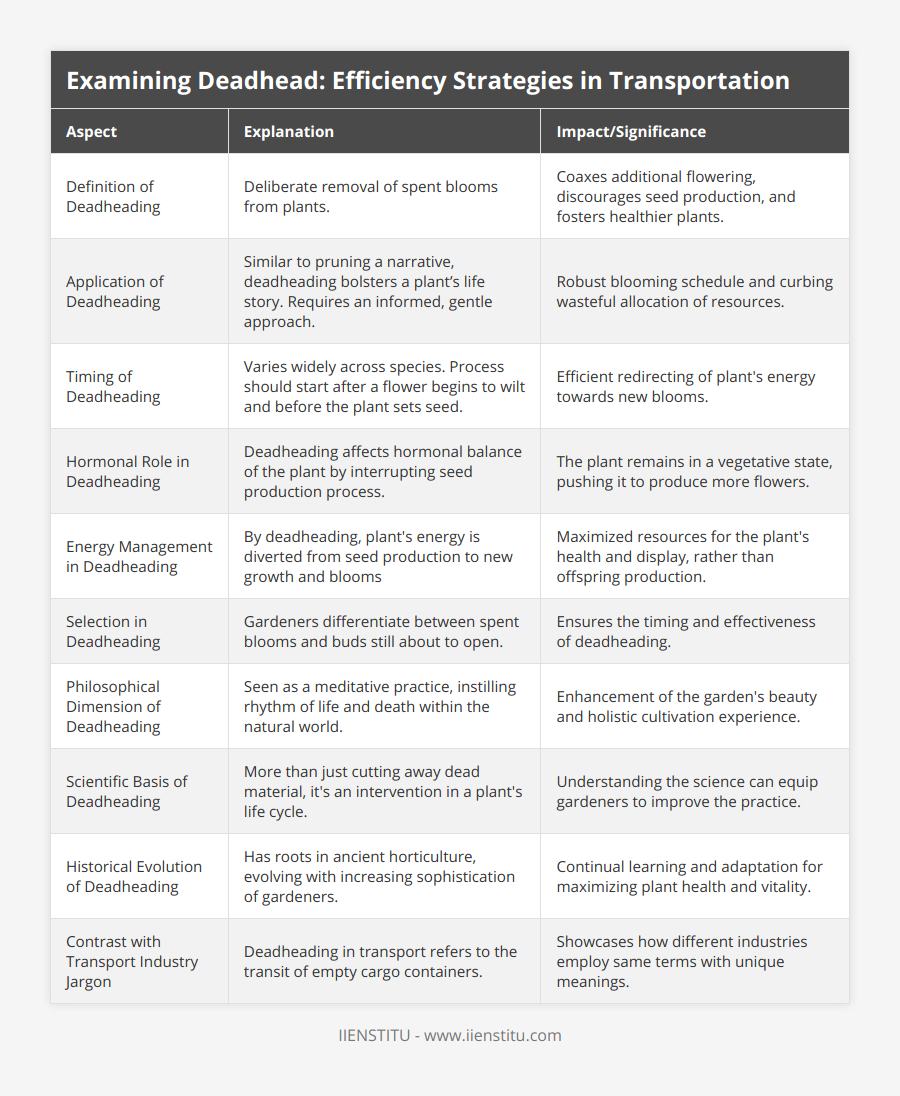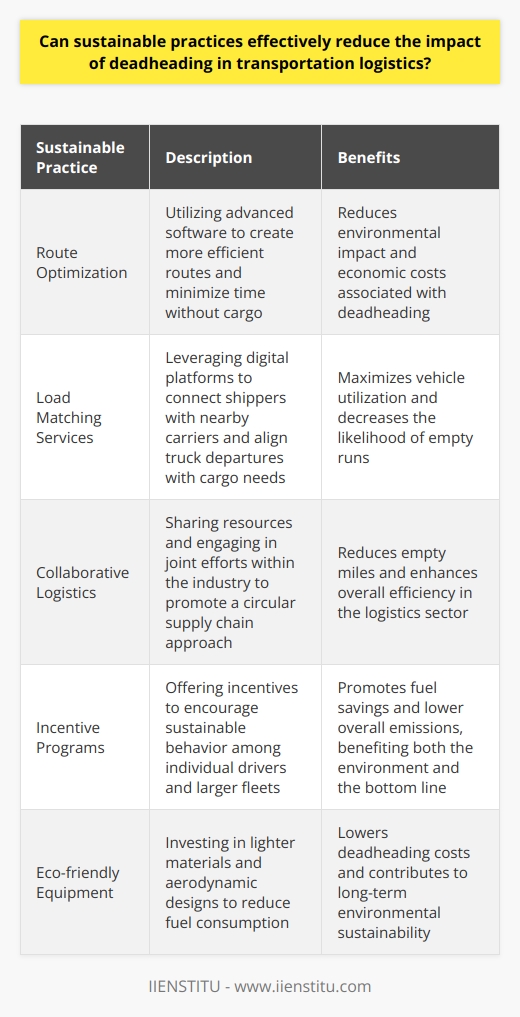
Gardening is not just about planting seeds and watering them; it's an art and a science that requires meticulous care and knowledge. One critical aspect of gardening that often goes overlooked is the practice of deadheading flowers. When I first heard the term "deadheading," I thought it was some kind of jargon used in the logistics industry, referring to the transportation of empty cargo containers. However, as I delved deeper into the world of gardening, I realized that deadheading has a unique definition and plays a crucial role in maintaining the health and beauty of plants.
I remember the first time I attempted to deadhead my rose bushes. It was a warm summer evening, and the sun was just beginning to set. As I walked through my garden, I noticed that some of the roses had started to wilt and fade. I had read about the benefits of deadheading plants, but I was hesitant to try it myself. What if I accidentally damaged the plant or removed too much? Despite my doubts, I decided to give it a shot.
Armed with a pair of sharp pruning shears, I carefully snipped off the spent blooms, making sure to cut just above the first set of healthy leaves. As I worked my way through the bush, I couldn't help but feel a sense of satisfaction. It was like giving the plant a fresh start, allowing it to focus its energy on producing new growth and blooms.
The practice of deadheading has been around since the beginning of horticulture, and it has evolved over time as gardeners have become more sophisticated in their efforts to promote plant health and longevity. The value of deadheading lies not only in its aesthetic benefits but also in its ability to improve the overall vitality of plants.
According to a study published in the Journal of the American Society for Horticultural Science, deadheading annuals and perennials can significantly increase the number of flowers produced and extend the blooming period (Whitman et al., 2005). The researchers found that by removing spent blooms, plants were able to redirect their energy towards producing new growth and flowers, rather than setting seed.
But why is this important? Well, when a plant produces seeds, it signals the end of its life cycle. By removing the spent blooms before they have a chance to set seed, we are essentially tricking the plant into thinking it needs to continue flowering in order to reproduce. This not only results in a more attractive plant but also helps to keep it healthy and vigorous.
Of course, the process of deadheading varies depending on the type of plant you are working with. Roses, for example, require a slightly different approach than other flowers. When deadheading roses, it's important to locate the first set of healthy leaves below the spent bloom and make your cut just above them. This encourages the plant to produce new shoots and blooms, rather than becoming leggy and unproductive.
İmpact Of Smart Logistics Networks On Supply Chain Efficiency
Long Tail Keyword For Supply Chain Modeling Efficiency Optimization İnsights
Here are some tips for getting started with deadheading:
1- Use clean, sharp tools: Whether you're using pruning shears, scissors, or your fingers, make sure your tools are clean and sharp to avoid damaging the plant.
2- Know when to deadhead: The best time to deadhead flowers is typically when the blooms start to fade and wilt. However, this can vary depending on the type of plant, so it's important to do your research.
3- Don't be afraid to experiment: Deadheading is a learning process, and it may take some trial and error to figure out what works best for your plants. Don't be afraid to experiment and observe how your plants respond.
In addition to the practical benefits of deadheading, there's also something deeply satisfying about the process itself. It's a chance to connect with your plants on a deeper level, to observe their growth and development, and to take an active role in shaping their future.
As Christopher Lloyd, a renowned British gardener and author, once said, "Gardening is a way of showing that you believe in tomorrow." By deadheading our plants, we are not only improving their health and appearance today but also investing in their future.
But deadheading isn't just about the plants themselves; it's also about the tools we use to care for them. One of the most important tools for deadheading in gardening is a good pair of pruning shears. Look for a pair that feels comfortable in your hand and has sharp, clean blades. Felco, a Swiss company known for its high-quality garden tools, offers a range of pruning shears that are perfect for deadheading (Felco, 2021).
Another essential tool is a pair of gloves. While deadheading isn't typically a thorny task, it's still a good idea to protect your hands from dirt and debris. Look for gloves that fit well and allow for plenty of dexterity, so you can easily grab and snip spent blooms.
Of course, no discussion of deadheading would be complete without mentioning the importance of timing. The best time to deadhead flowers is typically in the morning or early evening, when the plants are not under stress from the heat of the day. This allows them to recover more quickly and reduces the risk of damage.
It's also important to note that not all plants require deadheading. Some, like sedum and ornamental grasses, have attractive seed heads that provide winter interest and food for birds. Others, like impatiens and begonias, will drop their spent blooms on their own, making deadheading unnecessary.
So, how do you know which plants to deadhead and which to leave alone? The best approach is to do your research and observe your plants closely. Look for signs of fading or wilting blooms, and consider the overall health and appearance of the plant. If in doubt, err on the side of caution and leave the plant be.
In conclusion, deadheading is a simple yet essential practice that every gardener should know. By removing spent blooms, we can encourage our plants to produce more flowers, improve their overall health and appearance, and extend their blooming period. Whether you're a seasoned pro or a beginner just starting to explore the world of gardening, deadheading is a skill worth mastering.
So the next time you're out in your garden, take a moment to observe your plants and consider the benefits of deadheading. With a little bit of knowledge and practice, you'll be amazed at the difference it can make.
Happy gardening!
References
Felco. (2021). Pruning shears. Retrieved from https://www.felco.com/us_en/products/pruning-shears.html
Whitman, C. M., Heins, R. D., Cameron, A. C., & Carlson, W. H. (2005). Influence of deadheading on flower production and plant architecture of garden phlox 'Franz Schubert'. Journal of the American Society for Horticultural Science, 130(4), 554-559.

Frequently Asked Questions
What are the key considerations when implementing efficiency strategies to address deadheading in transportation logistics?
Deadheading in Transportation Logistics
Understanding Deadheading
Deadheading refers to the movement of an empty vehicle after offloading. It occurs often in trucking, shipping, and air transport. This practice leads to inefficiency. It wastes fuel, time, and labor. It also increases vehicle wear and tear. Thus, addressing deadheading is vital.
Key Considerations for Efficiency
Analyze Return Trips
Efficiency improvement starts with return trip analysis. Logistics managers must know when deadheading happens. They should identify routes and times prone to empty returns. This information guides corrective action.
Maximize Load Opportunities
Securing backhaul loads is essential. Every trip should contribute to revenue. Databases of potential loads can help. Such tools match outbound and return trips with freight. More matches mean fewer empty runs.
Optimize Routing
Route optimization is also key. It reduces deadheading directly. Efficient routing software is now available. This software analyzes numerous variables. These include traffic, weather, and vehicle type. It finds the best route in real-time.
Leverage Telematics
Telematics plays a role. It provides real-time data. Managers can make better decisions with it. This technology tracks vehicles to minimize empty miles. It improves overall fleet efficiency.
Implement Collaborative Logistics
Collaboration is another consideration. Partnering with other companies may reduce deadheading. Shared distribution channels and resources work. It leads to a shared benefit in reduced transportation costs.
Embrace Flexible Scheduling
Flexible scheduling is beneficial. It can ensure vehicles are full more often. This may require adapting to customer scheduling. But the gains in reduced deadheading can justify it.
Focus on Load Consolidation
Load consolidation is a technique to consider. Combining smaller loads into one larger load is its premise. This reduces the number of trips needed. Efficient load consolidation requires precise coordination.
Incentivize Efficiency
Incentivizing drivers is effective. Rewards for reducing empty miles can drive behavior. This results in fewer instances of deadheading. It promotes a culture of efficiency in the organization.
Evaluate Equipment
The type of equipment matters. Some vehicles are more prone to deadheading. Choosing versatile equipment can help. It should suit different types of cargo. Thus, it can carry varied loads, reducing the empty return trips.
Measure and Refine
Lastly, continue to measure performance. Understanding what works is crucial. Regular analysis of strategies and their outcomes is needed. Refine strategies based on data collected. This ensures continuous improvement.
Conclusion
Addressing deadheading requires a multi-faceted approach. It involves data analysis, technological tools, and collaboration. Flexibility, incentives, and equipment choice also play roles. Steady measurement and refinement anchor these efforts. This leads to more efficient, cost-effective transportation logistics.

How do technological advancements contribute to minimizing deadhead miles in the freight industry?
Technological Advancements in Freight Management
Reducing Deadhead Miles
Deadhead miles pose challenges. They drain profits. They increase carbon footprints. The freight industry constantly seeks efficiency boosts. Technology plays a pivotal role. Innovations are instrumental. They streamline operations.
Dynamic Routing Systems
Intelligent routing changes the game. It relies on sophisticated algorithms. These prioritize optimal paths. They adapt in real-time. They consider numerous variables. Traffic, weather, and road conditions matter. So do vehicle specs. Load types influence choices. Resulting routes minimize deadhead miles. They save fuel. They reduce emissions.
Telematics and Real-time Data
Telematics integrate communication technologies. They gather extensive data. Trucks become connected assets. Fleet managers receive real-time updates. They track vehicle locations. They monitor performance statistics. Fuel efficiency becomes transparent. Maintenance needs are clear. These insights inform better dispatch decisions. Deadhead miles drop as a result.
Freight Matching Platforms
Digital freight matching transforms logistics. It connects shippers with carriers. It's like a ride-sharing app. But for cargo. Carriers locate nearby loads. Trucks seldom travel empty. Efficiency climbs. Deadhead miles plummet.
Predictive Analytics
Data analysis highlights patterns. It anticipates future needs. Predictive analytics support informed decisions. Potential deadhead trips surface early. Countermeasures follow swiftly. Industry trends become clear. Route optimization gains sophistication.
Autonomous and Electric Vehicles
Self-driving trucks are emerging. They promise revolution. They promote continuous operations. Human fatigue won't limit them. Optimized driving mannerisms save fuel. Electric vehicles offer promise too. They lure the industry with efficiency. Zero tailpipe emissions attract environmental concern.
Internet of Things (IoT)
The Internet of Things (IoT) links devices. It sends, receives, and acts on data. In the freight industry, IoT improves tracking. It enhances asset utilization. Improved resource allocation minimizes empty runs. Knowledge of trailer locations aids. Idle assets become active faster.
Environmental Impact Tracking
Awareness of environmental impact grows. Companies seek greener operations. Technology aids in this pursuit. Deadhead mile reduction plays a part. Software quantifies carbon footprints. This motivates ecological efficiency.
Conclusion
Technological advancements are pivotal. They cut deadhead miles. They enhance sustainability. They save costs. They improve the freight industry's image. The road ahead is clear. Innovation steers the way. The industry must embrace it. Progress depends on it.

Can sustainable practices effectively reduce the impact of deadheading in transportation logistics?
Understanding Deadheading in Transportation
Deadheading occurs when a transportation vehicle operates without carrying any cargo. This is especially relevant in trucking and shipping industries. It can significantly impact both profitability and environmental sustainability.
Impact of Deadheading
Deadheading contributes to wasted fuel. It also increases emissions. Economically, it represents a lost opportunity. These factors combined signal a need for better practices.
Reducing Deadhead through Sustainable Practices
Route Optimization
Advanced software can decrease deadheading. It can ensure more efficient routes. Optimized routes mean less time without cargo. This reduces environmental and economic costs.
Load Matching Services
Digital platforms can align truck departures with cargo needs. They can connect shippers with nearby carriers. This maximizes vehicle use. It decreases the chances of empty runs.
Collaborative Logistics
- Sharing resources benefits the entire industry.
- Joint efforts can reduce empty miles.
- It promotes a circular supply chain approach.
Incentive Programs for Reduced Deadhead
Incentives can encourage sustainable behavior. They work for individual drivers and larger fleets. Fuel savings serve as a solid incentive. Lower overall emissions is another.
Eco-friendly Equipment
Lighter materials mean less fuel consumption. Aerodynamic designs can also lower fuel needs. These upgrades demand initial investment. Yet, they can pay off by reducing deadheading costs.
Measuring Success
Metrics are crucial for assessing progress. Fuel savings measure immediate impact. Emission decrease tracks long-term environmental benefits.
Conclusion: A Holistic Approach
Deadheading reduction requires various strategies. Sustainable practices hold promise for positive change. Continued innovation and cooperation are essential. Together, these efforts can greatly mitigate the effects of deadheading in the logistics sector.



